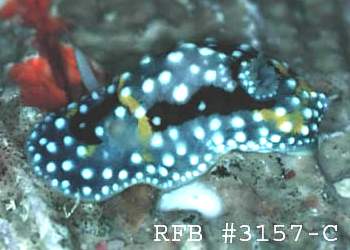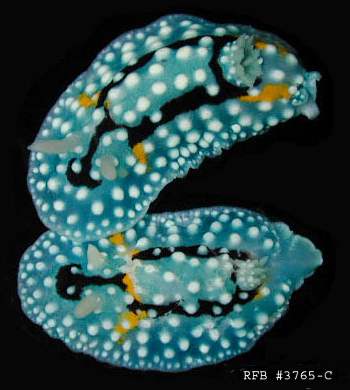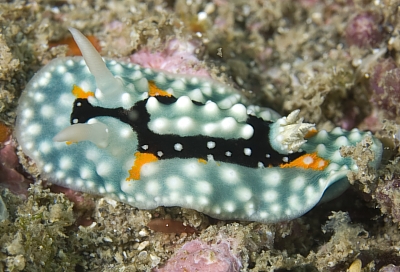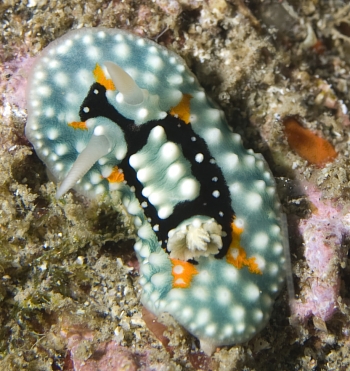

Aldisa albatrossae
Elwood, Valdés, & Gosliner, 2000
Order: NUDIBRANCHIA
Suborder: DORIDINA
Superfamily: EUDORIDOIDEA
Family: Dorididae
PHOTO
Upper Photo: Holotype specimen (California Academy of Sciences, CASIZ 89034).Length: 19mm., Depth: 20', Seragaki, Okinawa, 3 April 1993.
Lower Photo: Lengths: 16mm + 22mm, Depth: 10'., Seragaki, Okinawa., 18 Feb 2000. Photos: R.F.Bolland.
The following description of external characters is modified from the original description of Elwood, et al. (2000):
The dorsum of the living animal is a translucent bluish gray, darker at the edges of the mantle and lighter towards the middle of the body. The mantle is covered by numerous white rounded tubercles, and has a distinctive black pattern, which is virtually identical in all specimens examined. There is a black elongate patch in front of the rhinophores. From this patch there is a thin black line running back between the rhinophores to link to a black rectangular mark which runs back to just enclose the gills. A secondary black line runs across the front of the gill pocket. These characteristic black markings can also be seen in the preserved specimens. There is also a pattern of yellow-orange markings on the mantle, associated with the corners of the black rectangular pattern. The rhinophores are translucent off-white and lamellate, containing 18 lamellae in a 21 mm long specimen. The gills are similarly coloured and range from 6-9 in number. They are bipinnate and relatively sparsely branched.
Each rhinophore is surrounded by four tubercles. These tubercles also alternate large and small with the larger tubercles on the left and right sides of each rhinophore. The anterior portion of the foot is grooved but not notched. The head has short oral tentacles with a short groove along their outer edge. Grows to 22mm long.
See Aldisa erwinkoehleri and Aldisa williamsi.
Reference:
Elwood, H.R., Valdés, Á., & Gosliner, T.M. (2000) Two new species of Aldisa Bergh, 1878 (Mollusca, Nudibranchia) from the Tropical Indo-Pacific. Proceedings of the California Academy of Sciences, 52(14): 171-181, 5 figs.
Rudman, W.B., 2003 (August 28) Aldisa albatrossae Elwood, Valdés, & Gosliner, 2000. [In] Sea Slug Forum. Australian Museum, Sydney. Available from http://www.seaslugforum.net/find/aldialba
Related messages
Aldisa albatrossae from Lembeh
September 25, 2007
From: Sean Kearney

Dear Bill,
I just returned from another great trip to Lembeh. I will post other slugs as time permits. For now I need help confirming the id of this beautiful specimen. It appears to be quite similar to Aldisa albatrossae. I do see some differences from the description in Bob Bolland's message [#10828] and from the related messages. The black pattern does not seem to meet behind the gill pocket, and the mantle edge is lighter than the rest of the dorsum. The largest tubercles seem to be isolated in the saddle, with the smallest within the black pattern and at the edge of the mantle. The color was green not blue. I would appreciate your help with an i.d.. As always, thanks for your great forum.
Locality: Lembeh Strait, 8 ft, North Sulawesi, Celebes Sea, 11 September 2007, Coral rubble. Length: 3/4 inch. Photographer: Sean Kearney.
Sean Kearney
skearney@dc.rr.com



Dear Sean,
What makes the Forum great are the contributors - so I return your thanks. When new species are described the description is are usually based on a small sample of the total population so we don't always have a good idea about all colour variations such as the ones you describe. Interestingly, in the original description, a colour painting is included of a specimen collected on the 1907-1910 Albatross Expedition to the Philippines - which is why the species is named 'albatrossae' [ middle right image is a copy of the painting]. That specimen has the same greenish background as your photos, and like your animal it lacks the black pigment behind the gills. I have no hesitation in identifying your animal as A. albatrossae.
-
Elwood, H.R., Valdés, Á., & Gosliner, T.M. (2000) Two new species of Aldisa Bergh, 1878 (Mollusca, Nudibranchia) from the Tropical Indo-Pacific. Proceedings of the California Academy of Sciences, 52(14): 171-181, 5 figs.
Best wishes,
Bill Rudman
Aldisa albatrossae from Okinawa
September 7, 2003
From: Bob Bolland


Hi Bill,
In a recent Forum post featuring Aldisa williamsi from Indonesia, I noticed that you haven't yet featured on the Forum a similar appearing animal, Aldisa albatrossae. Here are two images from Okinawa.
The upper photo is of the holotype specimen (California Academy of Sciences, CASIZ 89034).
RFB # 3157-C
TL: 19mm
Depth: 20'
Seragaki, Okinawa
3 Apr 1993
The lower photo is of two specimens together.
RFB # 3765-C
TL: 16mm + 22mm
Depth: 10'
Seragaki, Okinawa
18 Feb 2000
These are uncommon here and I've collected twelve specimens over many years of diving in Okinawa waters. The size range of the collected animals was from 11mm to 22mm and depth range was from 10 to 235ft (3~72m).
Cheers,
Bob
bollandr@rapid-link.ne.jp
Bolland, R.F., 2003 (Sep 7) Aldisa albatrossae from Okinawa. [Message in] Sea Slug Forum. Australian Museum, Sydney. Available from http://www.seaslugforum.net/find/10828Thanks Bob,
I have been waiting for someone to kindly send me some photos of this species
Cheers,
Bill Rudman
